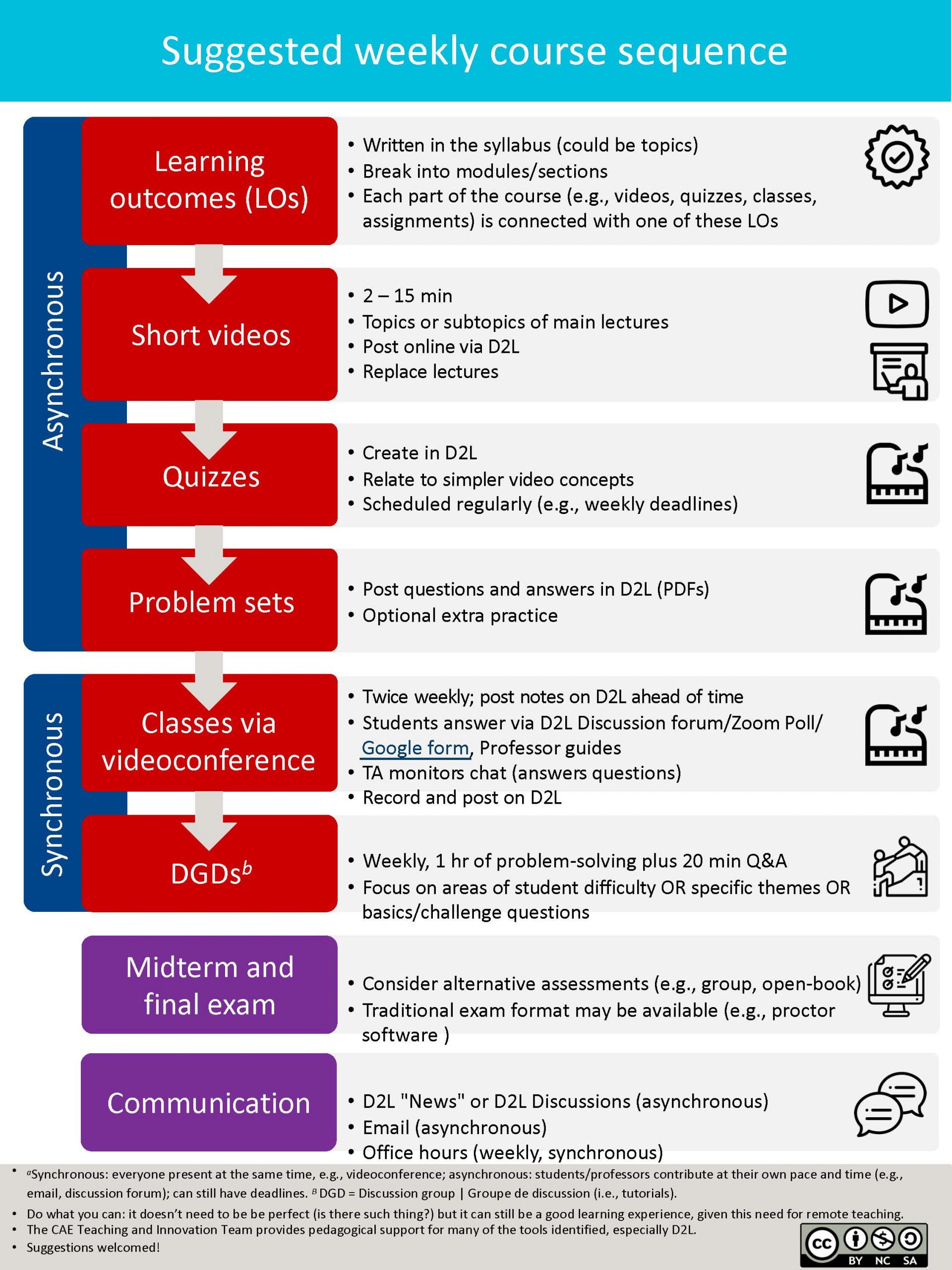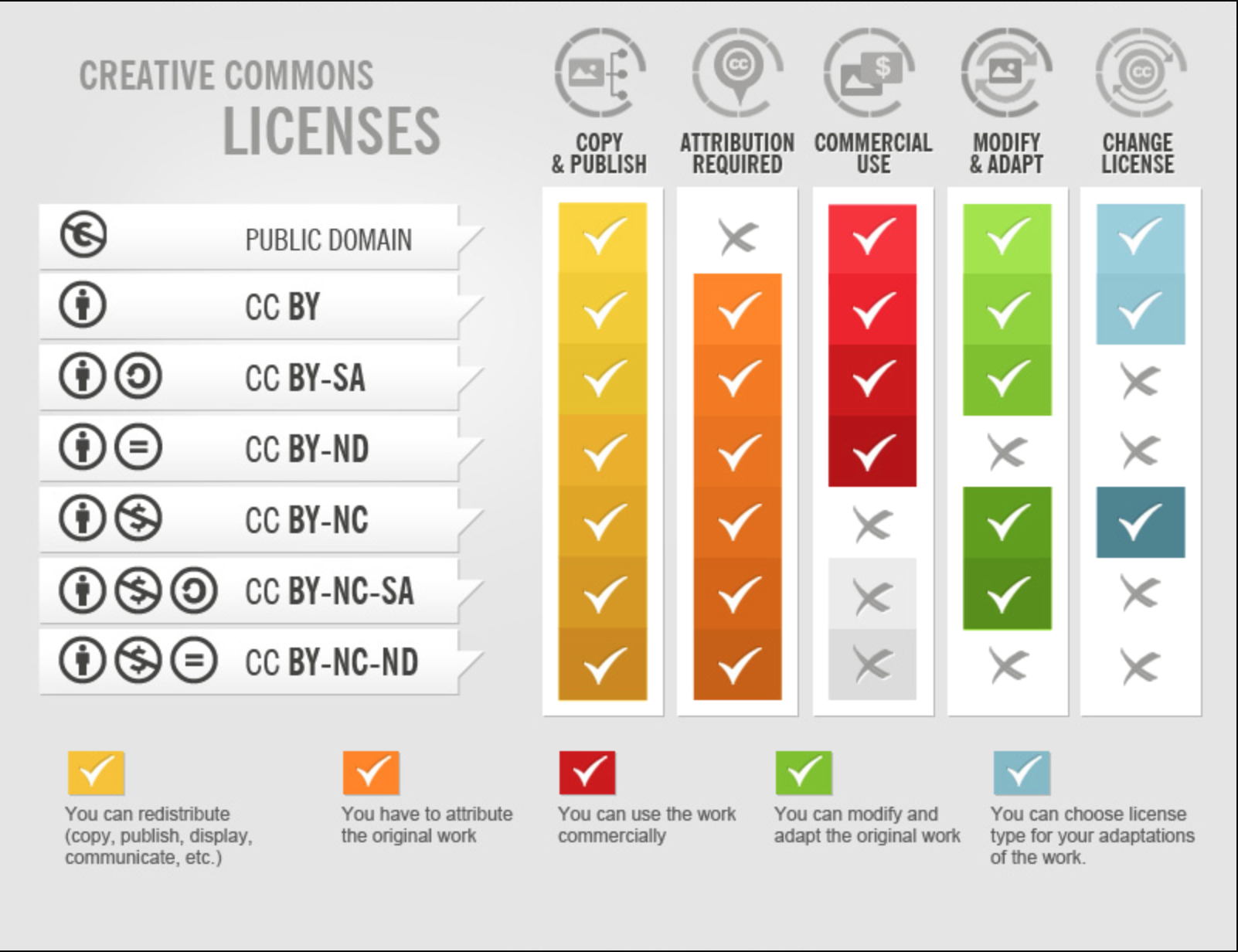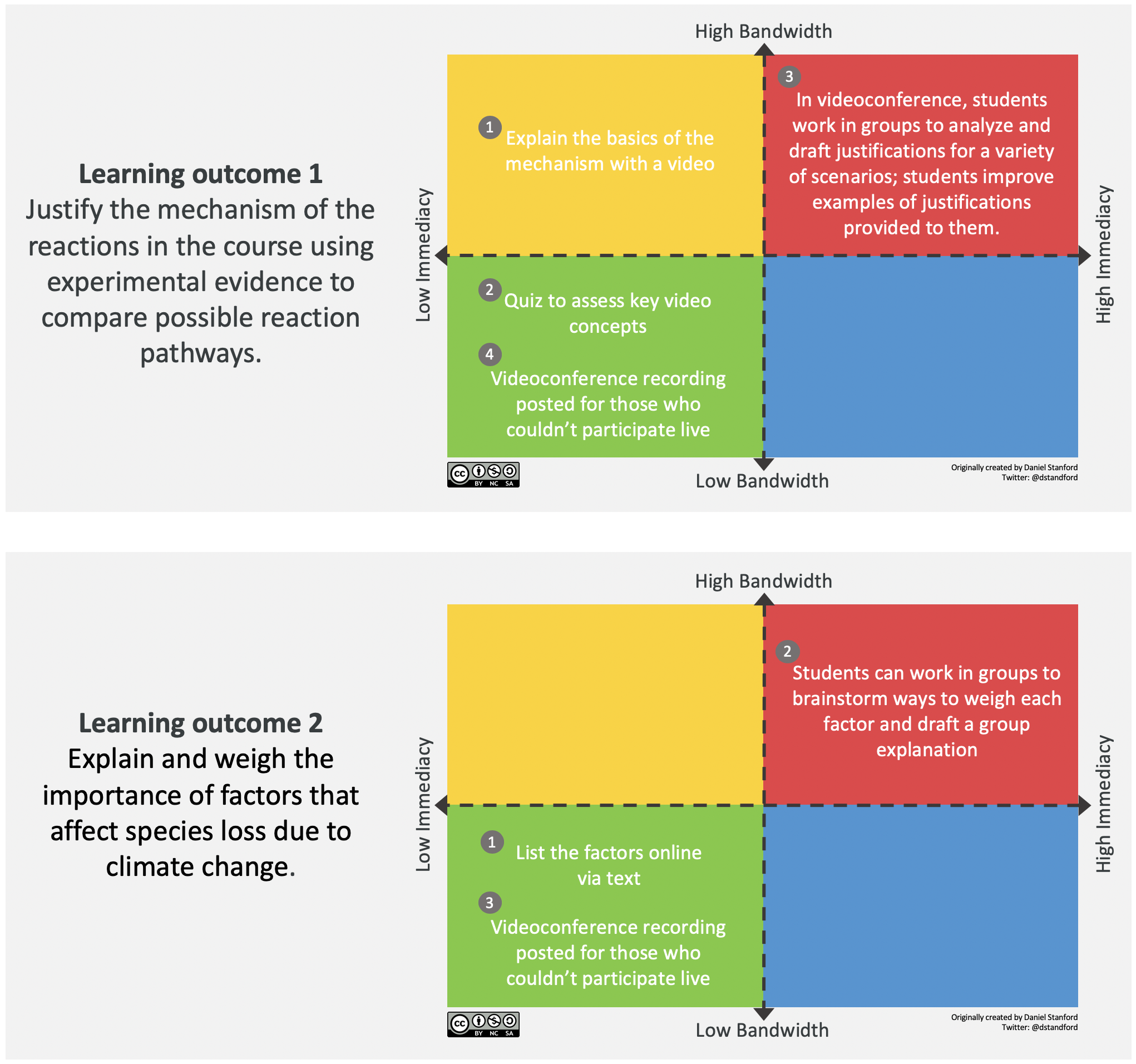4 Creating and sharing course content
This chapter will help you make decisions about how to best share the course content with your students. We then provide an overview of things that should be considered when curating and creating content.
Ideally, each course decision will be aligned with:
- The intended learning outcomes;
- Your intentions for the course, such as the learning experience you hope students will have;
- Abilities: both yours and the students’.
Suggested weekly overview
The following graphic depicts how the various elements can play out in a course. Please feel free to adapt and share with students; the PPT file can be found in the chapter: Quick start overview and resource documents.

Curating and creating content
Curate before creating
First, gather all the material you already have available to re-use if possible. Curating will save you time! There are many sources of content:
A main source of resources are Open Education Resources (OERs), which are “teaching, learning, and research resources in any medium—digital or otherwise—that reside in the public domain or have been released under an open license that permits no-cost access, use, adaptation, and redistribution by others with no low limited restrictions.” –UNESCO
To find OERs for your course, consult with the following resources:
- Ask the Laurentian University librarians
- Consult the list of OER repositories shared by the University of Ottawa
- eCampusOntario has an Open Library plus other teaching/learning resources
- Discipline-specific repositories exist, including for laboratories (e.g., ChemEdCanada.com, Merlot)
- Video sources such as Khan Academy
- Image sources, such as Pixabay, Flickr, and Flaticon
Copyrighted materials (video, text) may be desired sources. For these items, you could:
- Send students directly to the source by sharing a link
- Request or require that students purchase the material (e.g., course textbook)
- Explore copyright information through Laurentian University’s Copyright @LU webpage
Writing text or preparing slides
For online courses, full sentences are preferable to bullet points. Bullets on slides can be explained in person but the meaning can often be unclear when seen out of context. That said, be a brief as possible an avoid being redundant–repeating key points is important face-to-face as students may have missed the message or not realized the importance. Online, you can emphasize the key messages and they can always return.
Creating videos
As needed, create new material. There are great explanations for creating instructional videos (e.g., Columbia, Edutopia, TechSmith).
In short, you should stick to the following effective practices:
- Keep it brief (2 – 15 minutes, like TED talks). Long video recordings (i.e., > 20 min) are difficult for many reasons, as they make it hard to:
- participate without interruptions (bandwidth, family responsibilities, etc.)
- keep students engaged for that amount of time,
- find information later,
- update or clarify content, or
- point students to specific sections of relevance.
N.B. If there’s a mistake in an 80 minute video, it’s a lot harder to fix than a mistake in a 3-minute video.
- Ideally, videos will be centred on a single topic or subtopic
- Identify a key message, such as by learning outcome, topic, or subtopic in the course.
- Have accompanying visuals that can be annotated, such as slides. Share these with students so that they can annotate, too (e.g., post the slides on D2L, use an editable format, like Powerpoint or Google Slides). More on creating videos and cognitive load from the Vanderbilt University effective educational videos webpage.
- Be engaging: use a conversational tone ; making mistakes is okay!
- Use your videos to increase engagement and impact by letting students see your face.
Video and recording tools
Here are some set-ups you can use. However, there are many options out there, so you can always look into others.
- Hardware – these are optional, aside from a computer to do the recording
- Webcam: your laptop/desktop’s built-in camera or a separate webcam, such as Logitech’s 960 or C615
- Tablet for digital handwriting: an iPad with pen or the Wacom pen tablet
- Microphone: the Snowball, Blue Yeti, MXL Tempo, or MXL conferencing; the built-in microphone on most computers is noticeably lower quality
- Headset: the Logitech wireless and wired versions are excellent value; a head-set is helpful if you plan to do lots of editing or doing more advanced recording
- Software
- Laurentian University recommends and offers technical support on: Powerpoint or Google Slides recorded using Panopto (in a classroom or using personal capture) or using voice-over Powerpoint from a laptop/desktop.
Other options (not supported by Laurentian) include:
-
- YouTube Studio (simple editing), iMovie (Mac only), TinyTake (good for short videos), Camtasia (records screen, video, and audio; simple to advanced editing, but more expensive). As usual, there are many other options if these don’t work for you.
- Notability captures annotations on blank pages or a slide – can be run on a tablet or desktop
- Powerpoint or Keynote, to make and share slides
To make the recording:
- Key principles: “A 5-Step Guide to Making Your Own Instructional Videos” from Edutopia and “The Ultimate Guide to Easily Make Instructional Videos” from TechSmith
- Cognitive load theory guidelines: “Effective educational videos” from Vanderbilt University.
- Integrating audio and video into your recordings: “How to Make Your Own Online Videos (in 30 Minutes or Less)” from Shopify.
To share the recording with students
- Create or upload the video in Panopto then share the link to the Panopto video in D2L. Using Panopto also allows for automatic captions (although expect greater error rates in technical material) ;
Other options:
- Upload the video to YouTube Studio (publicly or unlisted) then link to the YouTube video in D2L. Going through the YouTube step (i) allows for automatic captions (although expect greater error rates in technical material), (ii) means students can make themselves a playlist to watch offline, and (iii) Youtube automatically optimizes videos for low bandwidth connections.
Content and video accessibility
Course content needs to follow the Accessibility for Ontarians with Disabilities Act (AODA). For example, export Word and PPT documents to PDF in the format “Best for electronic printing and accessibility)”, tag images with descriptions or label as “decorative image”, and add captions to videos Panopto will caption videos roughly.
Intellectual property and Creative Commons licenses
You may choose to follow a traditional copyright route for licensing the materials you create; however, there are other options that make the content more accessible while still retaining some rights.
Creative Commons (CC) licensing is a format that lets you decide how much flexibility to give for use of your work. For example, you may decide that your work may not be used for commercial use and that any adaptations of your work need to be shared forward in the same way. You may also decide to waive all your rights by using a CC0 or Copyleft license. This link will bring you to Creative Commons’ interactive tool to choose a license.

Building the course in D2L
D2L (Brightspace) offers guides and video tutorials for creating each aspect of the course in D2L. The Centre for Academic Excellence Teaching and Innovation team also offers one-on-one pedagogical support for building your course in D2L. Book an appointment with a member of the Teaching and Innovation team by emailing coffeehouse@laurentian.ca for one-on-one assistance!
In the sections below, we describe how to make specific decisions about sharing content.
Deciding how to share content
Synchronous versus asynchronous
Ideally, the remote course will have a mixture of synchronous and asynchronous learning options.
A purely synchronous remote course would involve live streaming lectures without recording them. Such a format is hard on learners, teaching assistants (TAs), and professors for many reasons:
- Technology limits access: students with poor/no wifi struggle to hear, see, and participate. Dropped connections mean missed information. Working in different time zones makes attendance difficult.
- Many students will have a poor experience if they can’t connect efficiently. Long, live lectures are difficult to engage in. These issues can lead to poor student experiences and they will understandably complain. These issues could lead to problems of recruitment and retention down the road if courses gain bad reputations.
- A solely synchronous course creates obstacles to learning. This online resource from Vanderbilt University regarding effective educational videos, demonstrates how students’ cognitive loads can get too high with too many things to keep track of. Problems with equity can grow even larger. Synchronous delivery imposes a fixed pace onto students, who may find it too fast or too slow.

Often, explaining basic concepts works well when students are given content to study at their preferred time and at their own pace (e.g., recorded videos). This is an example of asynchronous teaching.
Synchronous time (e.g., videoconference) can be used for students to practice in groups and receive immediate feedback. Videoconferences can be very useful in courses, but require high bandwidth and immediacy.
Considering bandwidth and immediacy
Bandwidth limitations will cause students (or you!) to lose access to the livestream intermittently or for a long time. Bandwidth problems are likely to arise for any number of reasons. Students (or you) will be working from locations that may be subject to wireless interference, remote, or they may not have access to high speed connections. Bandwidth problems can interfere with every part of synchronous teaching, like posing questions for students to discuss in a breakout room (like in Zoom). Students with bandwidth problems may need extra time to download materials before they can use them.
Challenges with immediacy can create or exacerbate equity issues. Immediacy refers to how quickly we expect responses from each other when interacting. For example, when present in person, we anticipate an immediate response when asking someone else a direct question (high immediacy); when we email, a delay is normal (low immediacy).
Immediacy requirements can present challenges. If students must work remotely, they may be working in an environment that is not particularly effective for studying at all times, or one in which there are many distractions or obligations; child care is one example. These issues apply both to students and professors.
We recommend that faculty consider alternate approaches to course delivery and refrain from extensive use of high immediacy/synchronous approaches. Ideally, students will have choices in when to attend to course obligations so that they can also balance their current life obligations. The figure below shows some examples of how various course activities rank in terms of bandwidth and immediacy. Access the PDF version of the bandwidth and immediacy document here.

In the following paragraphs, we share a series of examples that suggest ways to find reasonable tradeoffs between immediacy and bandwidth. Our intent here is to take some of the pressure off both students, TAs, and professors.
Examples
Each example that follows is a learning outcome followed by teaching decisions that reflect a specific compromise between high and low immediacy, and between high and low bandwidth requirements. Access the PDF version of the bandwidth and immediacy document here.

Time on task
Emphasize time on task over “contact hours”. Design opportunities to engage deeply with learning in authentic contexts, rather than superficial approaches. Here is a useful course workload calculator for estimating the amount of time students should spend on your course activities. The University of Windsor’s Office of Open Learning recommends that students should spend 6 – 9 hours per week on learning activities in a course, including lectures, watching videos, readings, working on assignments, independent research etc.
Additional readings and resources
Review the University of Ottawa’s alternatives to copyrighted materials to see how you might be including public domain, open access, creative commons, links, and insubstantial use materials.
The following book delves deeply into every facet of teaching online: Major, C. H. Teaching Online: A Guide to Theory, Research, and Practice; Johns Hopkins University Press, 2015.
As another option, eCampusOntario’s Ontario Extend is a professional learning program grounded in the belief that the impact of learning should be the primary motivator for creating technology-enabled and online learning experiences. It aims to empower educators to explore a range of emerging technologies and pedagogical practices for effective online and technology-enabled teaching and learning.”
Mayer’s Handbook of Multimedia Learning contains many principles for designing effective learning through multimedia.
The following article describes evidence-based best practices for creating videos, aligned with Mayer’s Handbook. See Table 2 in particular. Students’ satisfaction was higher with some video types than others, but learning outcomes did not differ; all videos were short (3 – 5 min). Choe, R. C.; Scuric, Z.; Eshkol, E.; Cruser, S.; Arndt, A.; Cox, R.; Toma, S. P.; Shapiro, C.; Levis-Fitzgerald, M.; Barnes, G.; et al. Student Satisfaction and Learning Outcomes in Asynchronous Online Lecture Videos. CBE—Life Sci. Educ. 2019, 18 (4), ar55.
Content can become interactive by adding questions to videos using H5P through eCampusOntario’s H5P Studio or other methods, so that students can self-assess as they watch.
Sample teaching videos
The University of Ottawa’s “Specific examples of video set-ups” guide contains explanations and examples of video set-ups.
Minimizing bandwidth
If you wish to optimize further, this article by Kyle Mackie discusses strategies to reduce bandwidth strain for students accessing course materials, including how to optimize video streaming and reduce file sizes.
Synchronous activities
The chapter on Communicating with students offers more explanations about how to facilitate synchronous sessions.
Up next
In the next chapter, we address options for assessments, including quizzes, assignments, and exams.
Please feel free to contact us at any time with questions, suggestions, and concerns by emailing coffeehouse@laurentian.ca.
Course alignment refers to the connection between intended learning outcomes, learning activities, assessment, and the course environment.
Cognitive load refers to the total amount of mental activity imposed on working memory in any one instant. Working memory is responsible for temporarily holding and processing information (thinking, reasoning).
The Accessibility for Ontarians with Disabilities Act (AODA). For example, export Word and PPT documents to pdf in the format "Best for electronic printing and accessibility)", tag images with descriptions or label as "decorative image", and add captions to videos (YouTube will caption videos roughly)
Creative Commons is an alternative licensing copyright scheme. While traditional copyright, broadly speaking, bars any substantial reproduction unless permission is obtained, Creative Commons licensing offers a “sliding scale” of permissions, which you, as a copyright holder, can adapt to your needs. Documents licensed under Creative Commons offer a wide range of materials which professors can use in their courses, and students can use in their assignments – articles, charts, images, etc. – all without having to request permission.
The easiest way to find documents licensed under Creative Commons is to do a web search which includes the words “creative commons” (include the quotation marks). Creative Commons also provides a more targeted search tool on their site.
https://copyright.uottawa.ca/what-is-copyright/alternatives-copyright
During synchronous instruction, the professor and students are online at the same time. Synchronous modes can include videoconferencing, discussion boards, etc.
Participants access and work on course materials at different times. Examples include email, discussion forums/chats, and assignments.
Teaching assistants
Temporary storage and processing of information occurs in working memory, which has very limited capacity.
Bandwidth describes the maximum data transfer rate of a network or Internet connection. More info: https://techterms.com/definition/bandwidth
Immediacy refers to how quickly we expect responses from each other when interacting (e.g., professor expects an answer from a student or student expects an answer from a professor). For example, when present in person, we anticipate an immediate response when asking someone else a direct question (high immediacy). In online (and pandemic!) environments, immediate responses can be more difficult when many learners may be taking care of family members, in a different time zone, etc. We can use low immediacy methods to take off some of that pressure, such as email or discussion forums and occasional high immediacy methods such as videoconferencing.
In Canada, copyright protection for most works, such as books and articles, lasts about 50 years after the death of the creator, whether or not the creator still holds the copyright. works may be in the public domain because a copyright holder has chosen to not claim copyrights. The Reproduction of Federal Law Order, for example, permits anyone, without charge or request for permission, to reproduce Canadian laws and decisions of federally-constituted courts and administrative tribunals in Canada.
Some public domain works can be found at the Gutenberg Canada and Project Gutenberg websites. Wikipedia: Public Domain Resources also lists many public domain resources.
After copyright expires, a work becomes part of the “public domain” and can be freely copied, distributed, adapted and performed without having to request permission from the author or having to pay any royalties.
https://copyright.uottawa.ca/what-is-copyright/alternatives-copyright
Open access is a growing movement in the scholarly publishing world, where authors and publishers make their works openly available to others, without a subscription fee. These works may be freely shared, increasing their visibility.
https://copyright.uottawa.ca/what-is-copyright/alternatives-copyright
Copying or making use of a portion of a copyright-protected work that is not “substantial” (i.e., even less than the “short excerpt” described in the Fair dealing guidelines) is permitted, and does not require any permission.
The Copyright Act does not define “substantial part”. In determining what constitutes a substantial part, the courts have focused on the quality of what was taken from the original work rather than the quantity that was taken.
https://copyright.uottawa.ca/what-is-copyright/alternatives-copyright
H5P (an abbreviation of HTML5 Package) is an open source plugin that gives you the ability to create, share and reuse content like interactive videos, interactive presentations, games, and quizzes to engage learners in your course.

